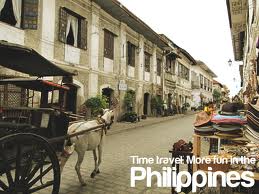The tourism campaign, “It’s more fun in the Philippines”,
of the Department of Tourism (DOT) was launched in January this year, serves as
a thematic platform, in application of cross-promotion, convergence
initiatives, and public-private partnerships, to all markets around the world.
Aside from the obvious definition, the Department would like
to spin the “FUN” to carry a deeper meaning encompassing “good governance and competitive
offerings that practice good business, proper management, and sustainable development.”
“FUN” then translates to easy, convenient, and hassle-free visitations that should
be evident across the tourism value chain, added the department.
 As part of its international campaign, the DOT released a TV
commercial via global media giant CNN that featured some of the most creative
memes from the public.
As part of its international campaign, the DOT released a TV
commercial via global media giant CNN that featured some of the most creative
memes from the public.
The department also participated in travel fairs and placed
ads in strategic spots. In particular, the campaign stickers on double-decker
buses, taxi cabs, and underground stations were reported to have received “overwhelming
support in London.” The roll-out included twenty-five double-decker
buses and fifty iconic black cabs that carried a uniform design of the slogan
and different faces of the Philippines. A billboard can also be spotted in Los Angeles, placed along
Century Boulevard and Aviation
Road near the LAX.
On the local front, the department shared the campaign logo
design and materials to partners in both the private and public sectors. Its
website, www.itsmorefuninthephilippines.com,
is currently being developed to feature more information such as places to see
in the country depending on tourists’ interests.
Sharing the fun, sharing the buzz
With about 25M Facebook and Twitter users in the Philippines,
the Department is tapping the power of social media to push the campaign
locally and create higher mileage. The
Department is also poised to launch audio-visual presentations, tv commercials,
print ads, and a photo library of fun photos this year.
As projected the Department is now confident that they will
be able to achieve its year-end target with the arrival of 1,819,781 foreign
visitors from January to May. Compared
to last year’s 1,609,651 visitors, this figure is 13.05 percent higher in
volume.
The Department also reported that all key markets registered
a positive growth from January to May, with Korea,
USA, Japan, China,
and Taiwan
maintaining their positions as the country’s top tourist generators. Korea remains to be the biggest
source, contributing 397,170 visitors for a share of 21.83 percent of the total
volume and posting a 12.41 percent growth.
Overseas Filipinos supplied 5.16 percent to the total tourist traffic
with 93,814 arrivals, exhibiting a steady growth rate of 4.26 percent.
Tourism chief Ramon R. Jimenez, Jr. said that the Department’s
goal is to rally the whole Filipino nation around a very simple idea: Tourism
is the people’s business.
“More than any other country in Asia, the Philippines has
the power of buzz and buzz creation beyond anything our competition can
generate. This same insight has been at the core of our new tourism campaign
with a central strategy executed and spread by millions of active, enthusiastic
Filipinos who feel they have the power to persuade people to visit their
country. Its phenomenal and viral success so far is greatly due to the people
who have participated in the campaign with their catchy and witty versions,
each proving to the world how it is indeed more fun in the Philippines. It is hoped that every
Filipino will continue to support the campaign and engage in becoming tourism
ambassadors who will ensure that our foreign guests will always have a positive,
memorable, and FUN experience,” added Jimenez.
Based on the 2011 Visitor Sample Survey for Inbound
visitors, the most popular destinations are Manila,
Boracay, Cebu, Laguna, and Tagaytay. These destinations are most visited by
tourists because these places continue to offer varied types of products and
activities, namely, sun, sea and beach, entertainment and shopping, sightseeing
and recreation.
In terms of popularity, fast-rising destinations from the
Visayas are Albay, Camarines Sur (especially Caramoan), and Samar. Tourist interest in these places is steadily
growing due to the untapped and natural resources and beautiful sceneries.
The Tourism Department also projects that the Bicol Region
and Eastern Visayas will be the next favored
tourist destinations once the needed infrastructure and investment in
accommodation and tourism products are completed.
More arrivals, more revenues
The DOT already completed the National Tourism Development
Plan for 2011-2016, that carries the ambitious target of 10 million
international arrivals, 35.5 million domestic travelers, that roughly
translates to Php1.9 trillion in tourism revenues, or 8.1 percent share to GDP
and 6.8 million employment.
To achieve these figures, the Department seeks the improvement
of NAIA and other secondary international airports, the development of an
online reservation system for access to Puerto Princesa
Underground River,
the adoption of a new “Five Star Grading System” as new national accommodation
standards for hotels, resorts, and other accommodation establishments.
In the capital city of Manila,
the Department has planned improvements at the Rizal Park
by adding new LED lighting system, WIMAX coverage, installation of CCTV cameras,
and redevelopment projects of the Intramuros such as the construction of the
San Ignacio Church, the Maestranza, Fort Santiago,
and the Rizal Shrine.




Very well-written! As always. :-)
ReplyDelete